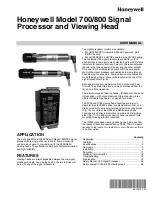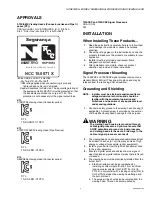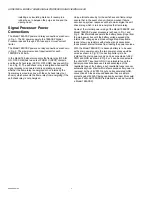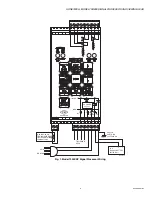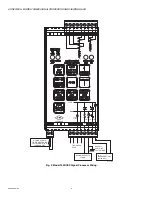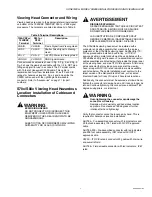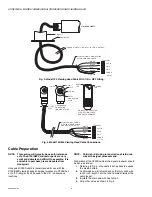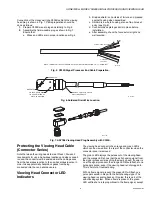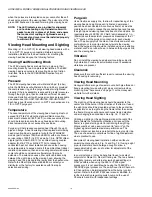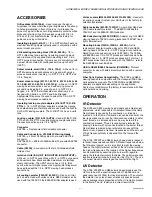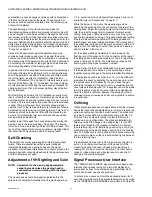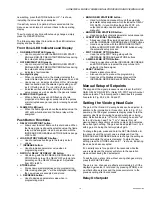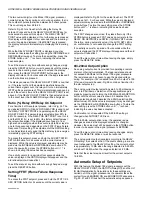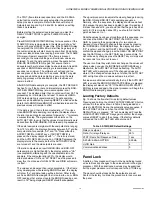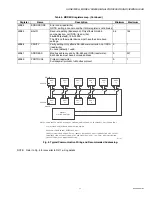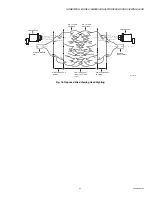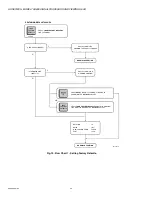
HONEYWELL MODEL 700/800 SIGNAL PROCESSOR AND VIEWING HEAD
66-2069EP—04
12
combustion process as oxygen combines with hydrocarbons
in the fuel in the blue part of the flame. The yellow part of
flames, and the background radiation from hot refractory, do
not emit UV radiation.
The spectral range of the UV tube makes it ideal for
discriminating between flame and glowing refractory. As with
any UV radiation, it can be absorbed or masked by unburned
fuel, smoke, oil mist, dirt dust and other impurities in the fuel.
Care should be taken to select the proper viewing head for the
fuel used. Additionally, the contaminants that mask UV can be
diluted by providing a strong flow of air through the sight pipe
to clear a viewing path through the attenuating material. See
It may also be desirable to sight the detector at an area
containing fewer masking agents such as near the burner
nozzle or near the entrance of the combustion air. Increasing
the viewing area of the detector by shortening the sight pipe or
by increasing the diameter of the sight pipe can also reduce
the attenuating effects of the masking agents.
In general, the UV viewing heads will work well on natural gas
and light oil flames. The sighting for both oil and gas flames
should be parallel to the axis of the burner and aimed at the
root of the flame, as with the IR detector. (See previous
section, “IR Detector.”) The highest UV intensity occurs near
the root of the flame (Fig. 17). In addition, the zone of higher
UV intensity does not overlap the same zones of adjacent or
opposing burner so that, with proper sighting, discrimination
can be achieved.
With low NOx gas burners, the UV radiation is usually much
less in intensity and spread out. Relatively high readings can
be obtained from all over the furnace when many burners are
in service. This is particularly true when flue gas recirculation
is used. There will however, be a relatively stronger signal
near the “root” of the flame and the more intense spot should
be located during the aiming or sighting process. This “root” or
intense spot may be further out than with the standard gas
burner so it is imperative that a swivel mount be used when
making sighting adjustments.
Another factor that needs to be considered when aiming the
viewing head is the load condition of the boiler. The flames
from a burner can be radically different at different loads. This
is one of the reasons for choosing an optimum sighting initially
that will minimize signal swing due to changing loads.
Self-Checking
The self-check circuitry guards against internal component
failure. There are several tasks that require intelligent
interaction between the viewing heads and the signal
processor. If all of these interactions do not occur properly, the
viewing head will not send pulses back to the signal processor
and the flame relay will open.
Adjustment of VH Sighting and Gain
NOTE: Adjustment to the viewing head parameters
cannot be made unless the viewing head is
connected and communicating with the signal
processor.
The viewing head should be properly sighted before the
setpoints are adjusted. Adjustment can be made easier by a
1/2 in. swivel joint, which Honeywell can supply if one is not
available (refer to “Accessories” on page 11).
While the burner is firing, vary the viewing angle while
observing the green LED on the connector at the rear of the
viewing head. Adjust the viewing angle for the maximum pulse
rate, then lock the swivel joint to preserve this mechanical
setting. If the green LED pulse rate is very high or very low,
see the two paragraphs below. The locked mechanical setting
should still be correct when Model 700 viewing heads are
interchanged, because inside each Model 700 viewing head
the optical axis is aligned with the mechanical axis within ±1/4
degree. Also, the reading shouldn’t change when a viewing
head is rotated in the mount.
For the above sighting adjustments to work properly, the
flashing rate of the green LED in the connector at the rear of
the viewing head must be reasonable. On the -PF (pipe fitting)
version, there are no LEDs. The installer must observe the
flame signal on the signal processor instead.
A count rate of 16 to 20 is recommended for proper operation.
If the displayed count is above 25, the pulses begin to blur
together, making changes in the pulse rate difficult to observe.
If the displayed count is less than 8 or 10, it will be difficult to
maximize the count by adjusting the viewing head aim, since
the pulses occur too infrequently. In such a case the gain
should be increased. If the gain is set to a maximum and the
count rate persists below 8 or 10, the system can still be made
to work reliably as long as the count rate drops significantly
when the flame is removed. However, the setup should be
reviewed for proper viewing head aim and sight path to ensure
it is optimized.
Orificing
Orifice disks have been used in applications with older viewing
heads that did not have adjustable gain in order to reduce the
extreme brightness of certain burner flames. The orifice disk
kit is part number M-702-6. Orifice disks come with 3/8, 1/4,
3/16 and 1/8 inch diameter holes. Contact the factory for
guidance is using orifice disks. The disks are installed with
retaining rings in the flange at the edge of the 1/2 inch NPT
female pipe thread for the process connection. An internal
type retaining ring is first installed by positioning a ring in the
machined groove inside the flange opening from the housing
side. The orifice disk is then inserted. Use a second retaining
ring to hold it in place so that it is sandwiched tightly between
the two retaining rings.
If the displayed flame count is 25 or higher when the gain is
set to 1, an orificing disc inserted in the back end of the
mounting block can be used. Choose a disc that gives a
reading of 12 to 24 at a low fire firing rate. The discs have a
range of orifice sizes; each size step results in about a 2:1
change in the counts displayed.
Signal Processor User Interface
The 700ACSP and 700DCSP signal processors have a user
interface that includes four lights, a two-digit display and
twelve push buttons for operation and programming. Each
button has at least one specific purpose.
To enter a menu, press and hold the applicable button for 2
seconds. Adjustments to the applicable setpoint can be made
via the INCREASE or DECREASE arrow buttons. To store the

